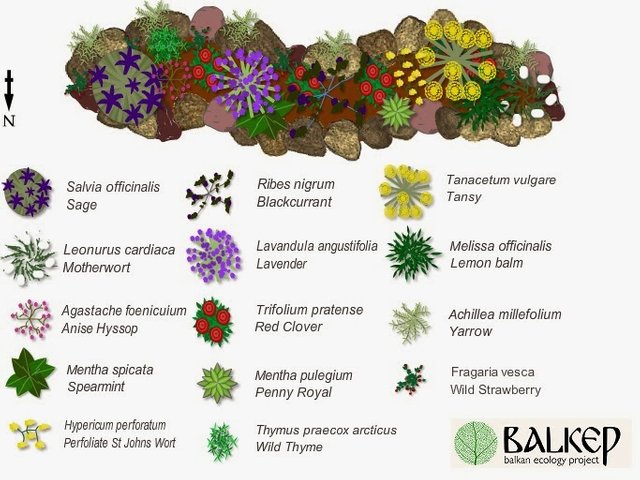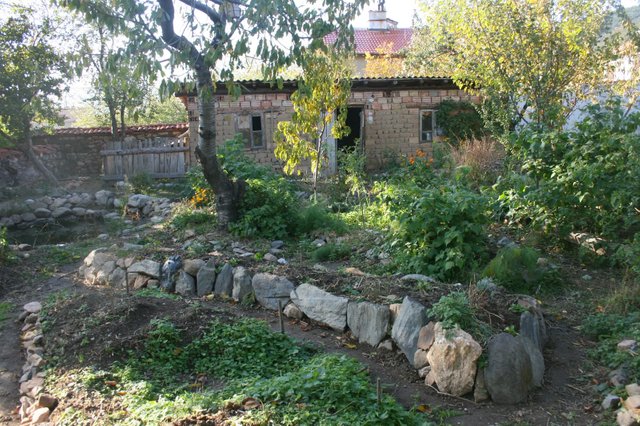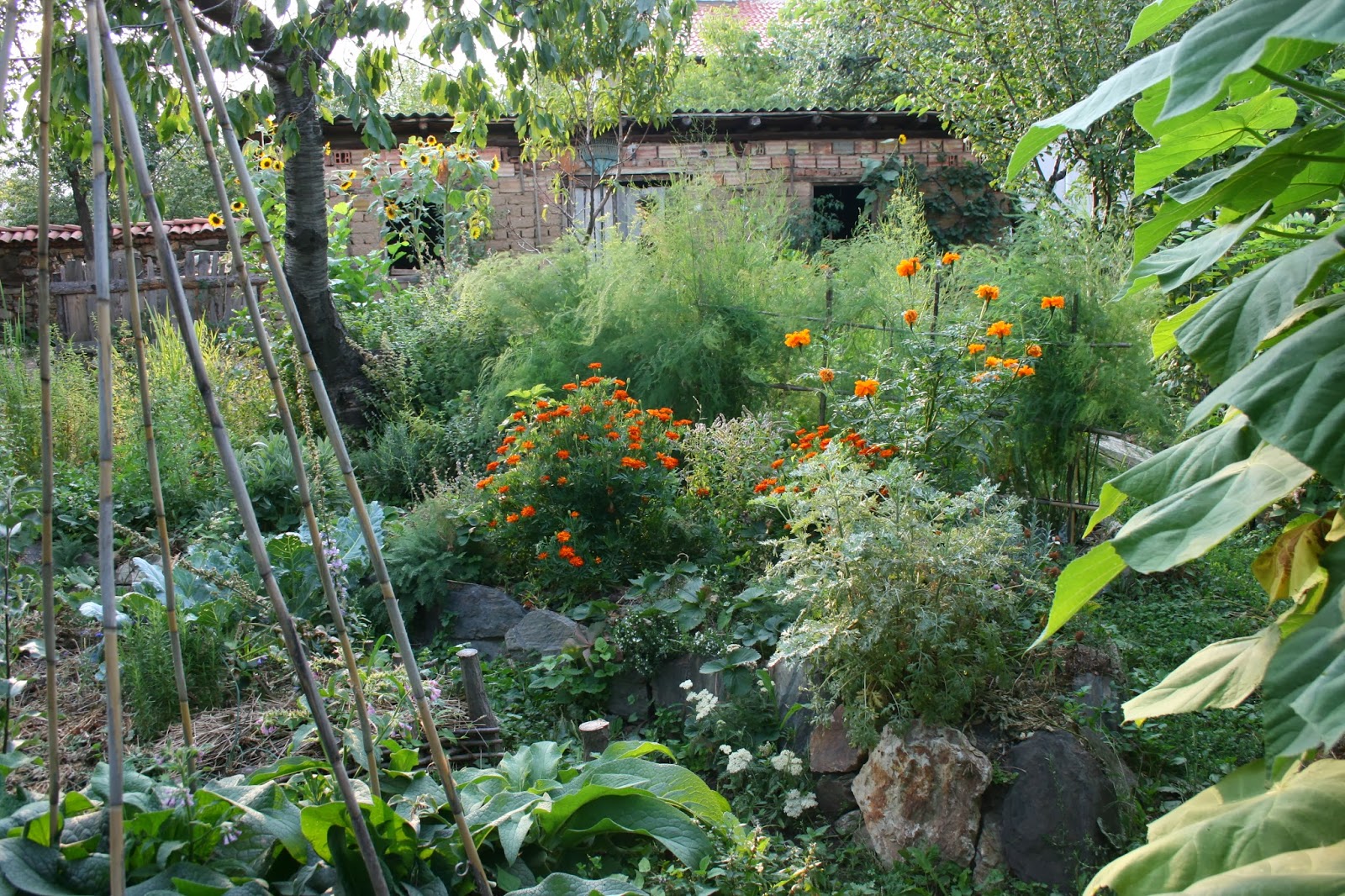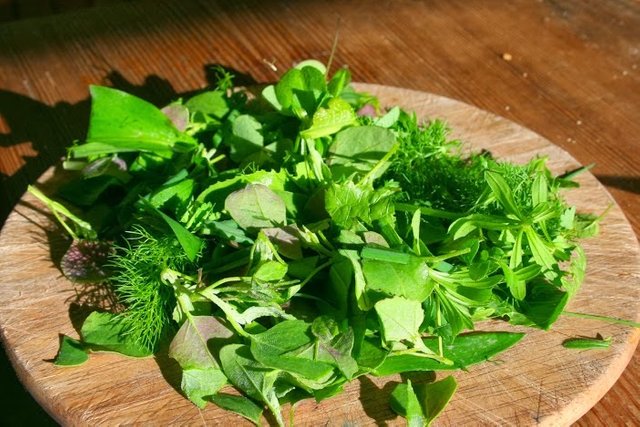The Chai Guild
The Chai Guild is your homegrown one stop shop for refreshing vitalising herbal teas and a living first aid cabinet. It also serves to attract a host of beneficial insects, provides habitat for many others, accumulates essential mineral nutrients and displays beauty and interest throughout the year. Oh - and I forgot to mention the strawberries, currants and salad leaves.
This is a perennial guild, meaning that the plants will live for more than two years, but in fact most of the plants in this guild will flourish for much longer than this. This community of plants is ideal for small gardens taking up no more than approx 6m2. It also works well in a larger space as a beneficial island that fills a gap within the wider garden ecosystem of fruit, nut and ornamental trees.
Species Overview
All the plants in this guild (apart from Agastache foeniculum) are native to Europe and all are well adapted to the climate and ecology of the Northern Temperate zone. We have been growing these plants in hardiness zone 5/6 for years, all the plants have tolerated temperatures down to -15C and less. Most of the plants are well adapted to dry conditions and will survive on average annual rainfall of 560mm. That said, we do not want our plants to survive we want them to thrive, and irrigating the plants during periods of drought will make for thriving plants. Irrigation is also necessary if you would like a decent yield of strawberries and black currants particularly when the fruits are forming.

A raised bed 6m x 1m bordered with rocks. Just one of many ways to combine these plants. Plant sizes are more or less accurately relative to the scale.
The plants are well suited to most soils excluding heavy clay, waterlogged soils and soils with pH in the extremes of acidity or alkalinity. If you have these type of soils they can of course be amended, but selecting plants to suit soils is a better option, both ecologically and economically. I made an exception to this rule when including Thymus praecox articus into the guild. This plant thrives on a nutrient poor soil, so I added a bucket of river sand into the bed and planted the Thyme into the sand. It seemed a shame to not include such an excellent tea and bee plant.
Functions and Uses
My goals when designing this guild were that every plant included can be used for making both fresh and dried herbal teas and that as a community the planting scheme should benefit the garden ecosystem. Below is a chart indicating the other uses and beneficial functions of the plant community.
.png)
Choosing the site for the Chai Guild
When choosing the position in your garden for this guild the main thing to consider is the positioning of your bed in relation to the sun and to match this up with the individual needs of the plants, ensuring that the sun loving plants are on the Southern facing side and the shade tolerant plants are on the North. (light needs listed below)
Depending on how much annual precipitation you receive in your area, it may also be important to position the bed so that it can passively collect water from rainfall e.g with a slight dip in the middle or at the base of a slope laid out on contour. This is relevant practice in Bulgaria where we can expect 8-12 weeks without significant rain during high summer, but not so relevant in the UK. The area where the rainwater accumulates should feature the plants that are more water demanding and obviously the area that will receive the least amount of water should be planted with drought tolerant species.(water needs listed below).
This self replenishing Chai Store/Salad Bar is there to be picked so making it easily accessible to you is an important factor when choosing its position.
Once you have established the footprint of your bed you can begin to build it. This can be as simple as piling up topsoil mixed with well rotted compost to a height of 50-70 cm in the desired shape and bordering your mound with large rocks or boulders laid in a small trench around the soil. Simple, that is, if you have lots of rocks and boulders nearby which we do. You could also build a retaining wall first and then infill with your top soil and compost. Bear in mind the bulk of the soil will reduce over the first 3-6 months as the soil settles.
For other ideas for edging in the ecological garden click here.

Chai Guild - Built and planted out in November 2012
Plant selection
Aside from selecting plants in relation to their space, light and water needs their ecological characteristics are also considered. Achillea millefolium - Yarrow is very drought tolerant and I use these plants evenly spaced in gaps between the boulders on the South facing edge(sunny side). The plant puts down deep roots that mine the subsoil for nutrients that would otherwise leach away with the ground water. The plant will spread very quickly, cutting back the spreading plants and dropping the material around the bed provides a source of these rescued nutrients to the other plants. Fragaria vesca - Wild Strawberry is planted on the edge of sunny side for ease of picking and will over time provide a self spreading ground cover through out the bed suppressing weeds and protecting the top soil from wind and rain erosion. Trifolium pratense -Red Clover is a nitrogen fixing plant that can be planted either side of the Blackcurrants - Ribes nigrum and in close proximity to the Fragaria vesca - Wild Strawberry. Cutting back this plant after you have used the flowers for a cup of tea will release some of the nitrogen fixed into the surrounding soil.
In the first season whilst your perennial plants establish you can plant annuals such as Tagetes patula or Centaurea cyanus to keep the ground covered. Both can also be used for teas.

Chai Guild - August 2013 with annual Tagetes patula and T.erecta added in the first season to fill space before the perennials grow.
Management
The plants in this guild will be competing for space both above ground and below ground. Above ground we can position our plants in a way that fills the available space. Pruning back growth that may be interfering with a slower growing plant should be practiced as you see fit with the cut material applied to the soil surface as a mulch and harvested for teas. I usually combine pruning with harvesting.
In the spring a 3 or 4 cm thick application of well rotted compost under the black currant and strawberry plants will ensure good fruit cropping. The windward side of the bed will act as leaf catchment in the autumn and raking up the leaves from the path and applying them to the surface of the soil will provide a good source of nutrients for the community.
Irrigating during dry periods will keep all the plants stress free and in good health. Always water heavily and infrequently as opposed to lightly and frequently. A good soak every 10-14 days in the dry season will be more than sufficient. As mentioned above the black currant and strawberries will benefit from watering when fruit is setting.
Click here to see the table - http://balkanecologyproject.blogspot.bg/2013/10/the-chai-guild.html
Plants such as Mellisa officinalis -Lemon Balm, Spearmint - Mentha spicata, Tansy - Tanacetum vulgare and Achillea millefolium will spread via rhizomatous growth (underground horizontal stems). After a few years these plants can be cut to ground level with the top growth applied to the surface then divided and moved to other areas around the garden or composted. You will need to hot compost the roots of these plants to ensure destruction of the rhizomes. These plants provide a great diversity of mineral nutrients to your compost. If you don't have hot compost leaving roots and stems of these plants in hot sun will destroy the rhizomes or soaking them in water for a few weeks and using the liquid as plant feed is another way of recycling the nutrients.
Harvest
Some of the plants included in this guild are known to cause skin irritations and can have toxic effects if consumed in large quantities. Please be aware of any known hazards associated with every plant you consume. You can find information on potential hazards along with medicinal properties and edibility by clicking on the links from the excellent PFAF website at the end of this post.
Caution aside we enjoy mixing and matching leaves and flowers from all of the plants in this guild to make phenomenal brews of healthy and invigorating teas.

Green Salad harvested in late April
Salads are best picked in the spring as the lush growth develops and in the autumn when the cooling temperatures and increased rainfall reinvigorates the plants. Summer growth can be quite tough and bitter but a few leaves mixed with more tender greens provides great flavor and interest. Do not include leaves of Leonurus cardiaca - Motherwort in the salads. Please remember that although Ribes nigrum - Blackcurrant leaves can be used for tea's other species in this genera such as Ribes rubrum - Redcurrants have leaves containing the toxin hydrogen cyanide.
As for medicinal value, all of these plants can be used to treat ailments but the best cure is prevention so get growing, get picking and drink up :)
Habitat Provision
If you have an available source of rocks and boulders they make great bordering material. The gaps between and under the rocks provide excellent habitat for arthropods. Some of these, such as Woodlice and Millipedes function as decomposers, speeding up the return of nutrients to the soil. Some of these are generalist predators such as centipedes and spiders. These creatures seek refuge from the sun and heat in the cool damp micro climate under the stones. I often find Praying Mantis egg cases overwintering in a rock crevice protected from the rain but warmed by the winter sun. These egg cases can hatch 100's of baby Mantids that have a voracious appetite for aphids. The rocks will also harbor creatures not so friendly to your plants such as slugs and snails and other phytophagous (plant eating) organisms. In our garden the frogs and toads seem to keep these under control.
Praying Mantis - Mantis religiosa egg case
Another benefit of using rocks is that being rocks they are laden with minerals that are released from the rock via chemical and physical weathering. These weathered minerals contribute to the soil stock. They can be thought of as the ultimate slow release fertiliser.
The above ground plant architecture itself also provides much habitat for many beneficial invertebrates to nest, feed, overwinter, hunt and reproduce as will the mulch layer covering the topsoil.
Beneficial Insect Interactions and Flowering times
Not only do the plants provide us with fine teas, salads and fruits they attract beneficial organisms such as ladybirds and hoverflies and lacewings the larvae of which are efficient predators of aphids. Furthermore, a succession of nectar bearing flowers keeps the bees and other pollinating invertebrates active and well fed in your garden for most of the growing season where they can assist with pollination of your surrounding fruit and vegetable crops. The table below provides information related to this.
click here to see the table - http://balkanecologyproject.blogspot.bg/2013/10/the-chai-guild.html
I love your work.
I've come up with similar designs but for warmer areas and called them Tea gardens.
Things like Ginger, lemongrass, Tulsi, Coffee - for the leaves. And many others
You've inspired me to write about that